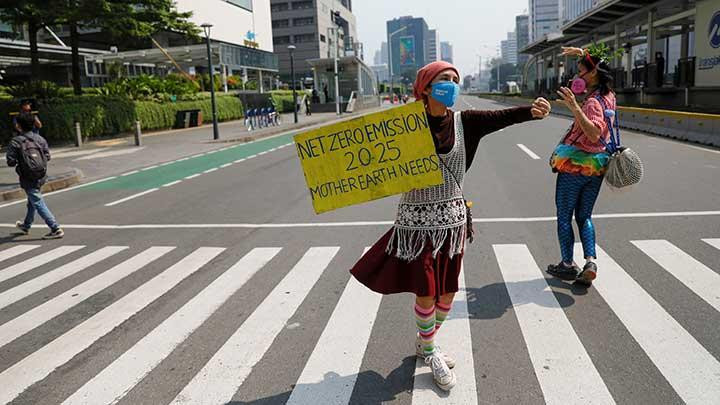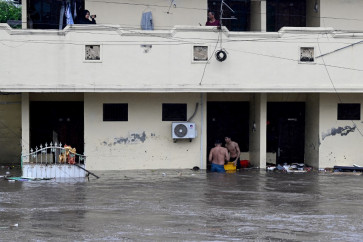Popular Reads
Top Results
Can't find what you're looking for?
View all search resultsPopular Reads
Top Results
Can't find what you're looking for?
View all search resultsInvesting in nature-based solutions to tackle triple plenary crisis
Nature-based solutions not only help to mitigate climate change by expanding natural carbon sinks, they enhance biodiversity, provide food and water, help clean the air and sustain other resources.
Change text size
Gift Premium Articles
to Anyone
F
or the past 50 years, April 22 has been observed as Earth Day to promote awareness of the health of our planet. Many experts view the three central challenges of the planetary crisis – mitigating and adapting to climate change, protecting biodiversity, and ensuring human well-being – as the defining issue of the decade.
A major part of the answer to tackle them lies in addressing these interdependent challenges together.
Indeed, the ethos of the Sustainable Development Goals (SDGs) acknowledges the interdependencies of the 17 environmental, economic, and social objectives and implements actions that promote synergies among them.
Despite the importance of considering synergies and trade-offs, according to a recent Economic Research Institute for ASEAN and East Asia (ERIA) study, many of the SDG goals are unlikely to be met by 2030 in several Asian countries. In particular, the failure to stabilize and adapt to climate change (SDG 13), protect biodiversity (SDG 15) and build Partnerships (SDG 17) are deeply interwoven and driven by the same set of economic drivers, but treated separately.
Against this backdrop, the United Nations climate conference in Glasgow (COP26) emphasized nature-based solutions as an integrated plan for people, government, and businesses to work closely alongside nature to avert a planetary catastrophe. While there is emerging consensus around nature-based solutions, the overarching concept encompasses a wide range of approaches and actions that involve the ecosystem, which addresses climate and biodiversity challenges while also benefitting human well-being.
In terms of climate change, it implies working with nature’s capacity to absorb greenhouse gases that cause global warming. This includes sustainable land-use practices and the management of forests that can remove carbon from the atmosphere and store it. It can also entail transformative actions in major sectors such as agriculture, livestock, land, water, and waste management to ensure the protection of the planet.
Nature-based solutions not only help to mitigate climate change by expanding natural carbon sinks, they enhance biodiversity, provide food and water, help clean the air and sustain other resources, as well as provide job opportunities, whilst also protecting local communities against natural disasters such as flooding, landslides, and droughts. Some estimates state that nature-based solutions have the potential to supply up to 40 percent of global climate change mitigation needs.
Moreover, nature-based solutions meet the cross-cutting goals of the key multilateral environmental agreements and conventions such as biological diversity, desertification, and forest conservation.
Across the Asia-Pacific, governments, communities, and the private sector are keenly adopting nature-based solutions approaches, with most of them incorporating this approach in their national climate plans.
Some examples include Indonesia’s afforestation program, which aims to restore about 600,000 hectares of forest and create thousands of jobs; Thailand’s response to the 2004 Indian Ocean tsunami by rehabilitating vast areas of mangrove swamps; and the Philippines campaign to plant one million trees in fragile watersheds.
However, to make nature-based solutions truly successful in tackling the triple planetary crisis, there are several issues that the global community must address with new thinking. One key challenge is the lack of an agreed framework or standards as to what constitutes an effective nature-based solution.
There are several misunderstandings that have led to applications of nature-based solutions that cause harm to biodiversity, wellbeing of communities and threaten to erode public trust in the approach. Examples include mass reforestation of single-species or non-native species, illegal land acquisition in marginal areas for reforestation, and curtailing of rights of Indigenous peoples in the new watershed conservation projects.
Another major challenge with the application of nature-based solutions comes in identifying appropriate indicators for measuring the socio-ecological impacts of identified interventions. For example, measuring the effectiveness of climate change adaptation measures such as flood control is often influenced by many interacting, context-specific factors that fluctuate over time. There is evidence that show nature-based solutions such as disaster risk reduction along coasts and river catchments can be more cost-effective than engineered alternatives.
The conservation of high-carbon ecosystems – such as peatlands, wetlands, rangelands, mangroves, forests and farming and animal raring practices – also delivers the largest and most timely climate benefits. Nevertheless, such nature-based solutions should not support or encourage carbon offsetting by polluting industries, to justify their continued growth in greenhouse gas emissions.
A strong assessment framework, metrics and standards must be developed to guard against the misuse of nature-based solutions and to ensure realizing effective economic benefits at local level.
There is a massive financing gap to be filled in realizing the full benefits of nature-based solutions. Funding for implementation comes from public and private sectors, bilateral and multilateral organizations, and national and international funds. One estimate shows that that if our planet is to meet targets for climate change, biodiversity, and land degradation, it needs to close a US$4.1 trillion financing gap, requiring quadrupling investments in nature-based solutions over the next 30 years.
Currently, climate finance for nature-based solutions such as community forestry projects is mainly provided through payments for ecosystem services programs, including carbon credits. However, raising the necessary finance for nature-based solutions is complex as many of the benefits cannot be capitalized by any single organization. They also often create many financial externalities that impact different investors groups, resulting in problems of ownership.
Of the estimated current flow of $130 billion per year directed toward nature-based solutions globally, only 14 percent is from the private sector. The lack of private sector funding is partly related to the long time-frame for returns on investments. Public funding thus has a crucial role to play in leveraging increased private funding by de-risking investments in nature-based solutions. Innovative financing mechanisms such as green bonds, credit swaps, debt-for-nature swaps, and carbon markets are also being actively explored but in different scope and scale.
Nature-based solutions need an effective governance system, as the implementation of them often involve multiple actors over a range of jurisdictional boundaries. For example, effective management of flood control using vegetative buffers in urban areas, requires joint decision-making across different local, regional, and national governments and among multiple ministries.
Therefore, to be successful, governance of nature-based solutions requires active cooperation and coordinated action between stakeholders, strong institutions, and a well-established planning process to ensure benefits are maximized and evenly distributed.
***
The writer is director of research strategy and innovation at the Economic Research Institute for ASEAN and East Asia (ERIA). The views are personal.










